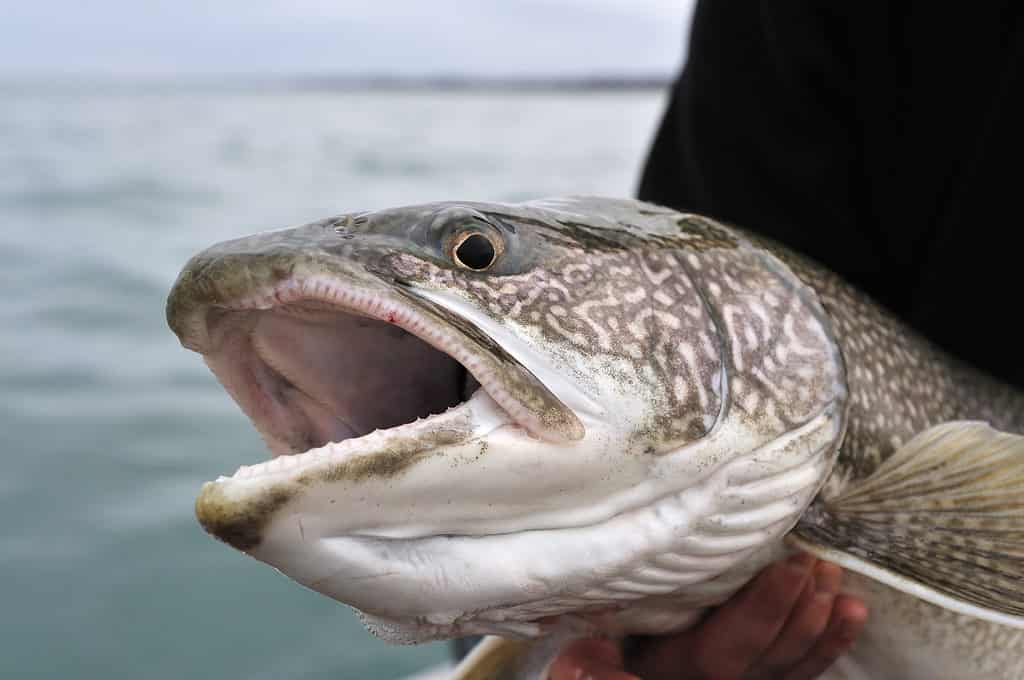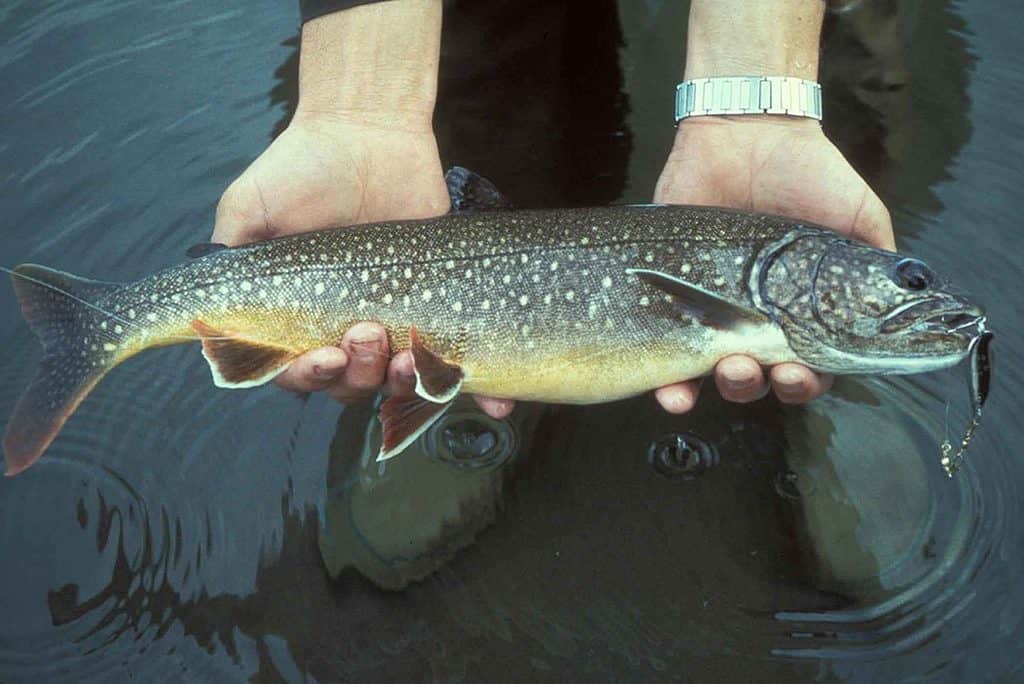Anglers describe ice fishing as a day of suffering, but it’s a great way to land absolute units! Lake trout reach incredible weights, so they’re a good choice if you’re looking for an ice-fishing monster. Discover the biggest lake trout ever caught when ice fishing and why, despite its awe-inspiring size, it’s not the world record holder.
The Biggest Lake Trout Ever Caught Ice Fishing
The biggest lake trout ever caught ice fishing weighed 52 pounds three ounces and measured 45 inches long with 32 inches girth. Ice fisherman Rob Scott caught it in Lac la Croix, Ontario, Canada, on February 8, 2014. This particular lake is half in Canada and half in Minnesota and is well known for excellent trout fishing.
Scott took an hour to reel in this monster icefish and reportedly said, “I felt like Captain Quint in Jaws.” His massive ice fish took 250 feet of line before he set the hook and started the land!
Why Is It Not the World Record?
However, there was bad news for Scott. He wasn’t eligible for the world record because he broke regulations! Ontario limits fishermen to one lake trout per day, and Scott had already landed a four-pounder earlier that day.
Despite handing his earlier catch to a friend, Minnesota’s Department of Natural Resources seized the monster ice fish, which, if legal, would have beaten the previous ice fishing lake trout record by 12 pounds!

The largest lake trout ever recorded weighed 102 pounds and measured 50 inches long.
©iStock.com/glxedwards
Lake Trout Through Ice: Official World Record
Earl Palmquist holds the official ice fishing lake trout record. In 1987, he caught a 40-pound, 43-inch lake trout from Clearwater West Lake Ontario. His record still stands.
All About Lake Trout
Lake trout are scientifically called Salvelinus namaycush in the family Salmonidae.
They’re North American natives that inhabit the Great Lakes from Nova Scotia to Alaska and were introduced to areas west of the Rocky Mountains. Lake trout have spread into the Great Lake tributary rivers, and they were introduced to the western United States, New Zealand, Sweden, and South America as sport fish.
They are cold-water-loving fish that inhabit 50 to 200 feet depths. The deepest recorded spawning depth is over 300 feet in Lake Superior, Michigan.
Diet
Lake trout are voracious predators at the top of the food chain. Juveniles eat zooplankton and small invertebrates, but adult fish are mostly piscivores that prey on other fish. They’re non-schooling, solitary fish and the only major native fish adapted to cold, deep, low-nutrient lakes.
Lake trout are also called “Great Lake trout,” “mackinaw trout,” “salmon trout,” “lake char,” “touladi,” “togue,” and “grey trout.” This fish of many names is a tasty eating fish, too!
Large lake trout have few predators, but in the Great Lakes, invasive sea lampreys primarily feed on them. Other predatory fish take juveniles.
Appearance
Lake trout are gray, green, or brown on top and have lighter bellies and deeply forked caudal fins. Yellow to white spots dot their skin. Experts suggest lake trout are darker on top, so predators looking into the depths can’t spot them, and lighter beneath, so prey looking up can’t spot them against the sun. They are masters of disguise, but this doesn’t matter when ice-fishing!
Lake trout live for decades and often reach 3 feet in length. The oldest lake trout recorded was over 60 years old!

Experts suggest lake trout are darker on top, so predators looking into the depths can’t spot them.
©U.S. Fish and Wildlife Service / public domain – License
Spawning
Lake trout spawn in fall on boulder beds that males scrape clean with their fins. Fertilized eggs sink into the rock crevices, and water currents keep them silt-free.
The largest females lay up to 20,000 eggs. When their fins are developed, they hatch into alevins and fan across the lakes. Small fry swims from the depths to the surface, hunting phytoplankton. Lake trout reach sexual maturity at seven and can live into their 60s.
Are Lake Trout Regulated?
Yes, strict ice fishing regulations exist, as we’ve seen in the case of Rob Scott! Regulations matter.
In the early 20th century, non-native lampreys and overfishing decimated the lake trout population. Sea lampreys entered the Great Lakes through canals that bypassed natural barriers. Lampreys are native to the Atlantic Ocean and the St. Lawrence River and are great lovers of lake trout, but today, these non-native- fish are controlled in the Great Lakes at their larval stage.
Officials regulated overfished waters in the latter half of the 20th century, so their population was steady. Each state has its own regulations.
What Is Ice Fishing?
Ice fishing is fishing through an opening in the ice. Ice fishermen use lines or spears.
Holes are cut with an axe, chisel, or specialized ice saw. Because it’s so cold, some fishermen erect ice shanties, also called ice shacks, around these holes to trap in the warmth. These shacks are towed into position using 4x4s, indicating how thick the ice is!

Holes are cut with an axe, chisel, or specialized ice saw in preparation for ice fishing.
©iStock.com/vladimirzahariev
Best Depth to Ice Fish for Lake Trout
Ice fishermen looking for lake trout recommend fishing at depths of 10 to 80 feet. Lake trout prefer deep, cold water but dart into shallower water to look for prey fish.
Do They Bite at Night?
Yes, lake trout bite at night. They are opportunistic predators that hunt wherever prey is active.
When to Ice Fish for Biggest Lake Trout
For most of the year, lake trout seek cold water that’s close to the bottom. In summer, they move to cooler, deeper waters, but when winter arrives, surface lake temperatures drop, and cold-loving lake trout come out for prey!
They hunt around structures for bait fish, dashing into shallower waters and eating until they’re full before retreating to the safety of deep waters.
Fishermen searching for ice-lake monsters set up ambush points around structures that attract schools of baitfish. The best locations are shallow bays, boulder reefs, coves, and the spaces between islands. Lake trout dash back to deep water after stuffing themselves with shallower-swimming baitfish.
Best Ice Fishing Baits for Lake Trout
Pescatarian lake trout eat smaller fish; bigger lake trout even take baitfish such as 14-inch walleyes. Large fish take larger prey, so a choice of big, flashy lures sunk near deep water will tempt ice monsters.
When they strike, be prepared. Big lake trout are powerful fish that snap an average line because they hit prey hard. Ice fishermen need size 8-14 hooks, heavy action jigging rods, and a powerful drag system with a 10–12-pound braided line. A braided line is important because sharp ice edges cut through thin lines.
Largest Lake Trout Ever Caught
The largest lake trout ever caught wasn’t through ice fishing but in a gill net. It weighed an incredible 102 pounds. Two anglers brought it ashore from Lake Athabasca, Saskatchewan, Canada, in 1961.
The largest lake trout ever caught on a rod and reel weighed 72 pounds. Lloyd Bull snagged it in 2005 in Great Bear Lake, Canada. Great Bear Lake also produced the longest lake trout catch. Michael Sadar caught a 52.5-incher in 2014.
Recap
Lake trout are one of ice anglers’ favorite fish to catch because they grow to epic proportions. The record lake trout caught through ice is still up for grabs. Earl Palmquist’s 40-pounder from Clearwater West Lake in Canada is the official record, but as Rob Scott demonstrated, there are larger lake trout to hook beneath the ice. His 52-pounder from Lac la Croix, Ontario, would have broken the record if it met regulations!
Where Is Lac la Croix, Ontario, Canada, Located on a Map?
Lac La Croix is a town located in Ontario, Canada, around 200 kilometers northwest of Thunder Bay. This remote town is situated in a scenic area that is known for its pristine lakes and abundant wildlife. Despite its distance from major urban centers, Lac La Croix offers a range of outdoor activities for visitors to enjoy, including fishing, camping, and hiking.
Here is Lac La Croix, Ontario, Canada, on a Map.
The photo featured at the top of this post is © Iryna Harry/Shutterstock.com
Thank you for reading! Have some feedback for us? Contact the AZ Animals editorial team.






